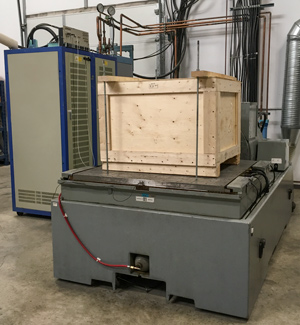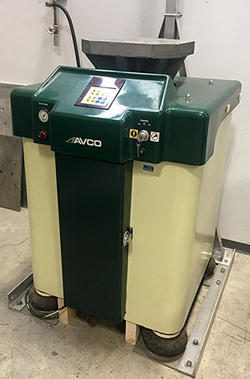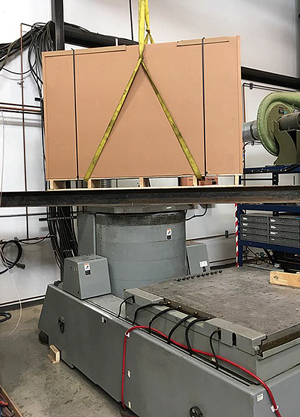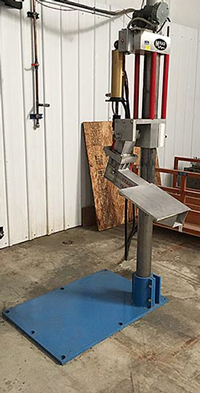Mechanical Testing
Vibration Tests |
Shock Tests |
Transport Simulation |
Loose Cargo Simulation and Drop Tests |
HALT/HASS
Vibration Tests

We are capable of doing vibration tests according to
Our vibration stand can simulate different situations and life cycles in a much shorter time frames: thousand miles on a highway can be a couple of hours on a vibration table; a bit more than a day can demonstrate equipment’s life cycle on a helicopter.
We can help you discover the limits of your product and design layout.
Main characteristics of our vibration stand include:
- Frequencies from 5 Hz to 2000 Hz*
- Amplitude up to 25 mm (1 inch)*
- Acceleration up to 100g*
- Maximum equipment weight 270 kg (600 pounds)*

Our vibration table can also perform shocks up to 75 g, allowing, in some cases, for vibration and shock tests to be performed simultaneously.
Shock Tests
The purpose of the shock test is to determine product’s robustness when it comes to a real-life environment.

While performing shock tests you can:
- find mechanical weaknesses in the construction;
- check unit’s degradation after repetitive shocks;
- simulate different regimes in a controlled environment
- adjust packaging to prevent damage from the transportation.
Our AVCO SM-110 shock machine has the following specifications:
- Test specimen weight up to 70 kg (150 pounds)*
- Shock testing from 3 g to 1000 g*
- Shock duration from 0.4 ms to 24 ms*
- 3 shock pulse generators: half-sine, saw-tooth, and square wave
We are capable of doing mechanical shock tests according to
Transport Simulation
 Electronics Test Centre has an extensive experience in transport simulation. Doesn't matter if you plan just a shipment of your unit by truck or it's installation in helicopter's cabin. We can simulate different situations and regimes, help you to determine weak points of the project or simply to choose between polystyrene and foam packaging…
Electronics Test Centre has an extensive experience in transport simulation. Doesn't matter if you plan just a shipment of your unit by truck or it's installation in helicopter's cabin. We can simulate different situations and regimes, help you to determine weak points of the project or simply to choose between polystyrene and foam packaging…
Equipment that is dedicated to be installed in on the transport units must meet strict vibration requirements from the specific industrial standards:
- RTCA/DO-160 covers all equipment dedicated to fly. It was first published in 1980, withstood a number of revisions, was adopted by all major aerospace and avionics manufacturers and was coordinated with European Organisation for Civil Aviation Equipment (EUROCAE ED-14G standard);
- MIL-STD-810 another military standard that has a wide variety of requirements for all kind of transport simulation: truck, trailer and composite wheeled vehicle, all kinds of planes and helicopters, ships and much more;
- ISO 16750 standard designed specifically for equipment that is going to be used in passenger and cargo cars. Was adopted by a number of car manufacturers and includes combination of temperature/vibration test.
Our lab has extended experience of transport simulation based on RTCA/DO-160 and MIL-STD-810.
We are also capable of performing vibration test with superimposed temperature cycle as per ISO 16750-3 (combined temperature and vibration testing).
Loose Cargo Simulation and Drop Tests

Might your product face some off-road transportation, or meet a rough loader during shipment? Packaging in our diversified and globalized world is extremely important. No one wants to receive a call from their end customer saying their order did not arrive in working order.
Our loose transport simulator and drop test can help you to analyse current packaging in a controlled environment revealing potential vulnerabilities, giving you the opportunity to take your product and/or packaging designs to the next level.
- Our loose transport simulator can hold up to 1136 kg of weight and provides frequencies up to 285 Hz. We are capable of doing loose transport tests according to MIL-STD-810 Section 514 and IEC 60068-2-55.
- The drop test can be performed according to the IEC 60945 Section 8.6.1, MIL-STD-810 Section 516 and IEC 60068-2-31 for landing on concrete, wood or steel surfaces.
On our vibration table we can also simulate delivery of your product by:
- Truck, trailer and composite wheeled vehicle on highways, gravel roads and offroads (based on MIL-STD-810)
- Passenger and commercial vehicles (based on ISO 16750)
- Ships, Planes, helicopters, etc.
HALT / HASS Testing
Regular environmental or mechanical tests (usually called stress screening) are focused on the operating performance of a product under normal environmental conditions in order to prove a products’ reliability. But the higher the stresses, the faster equipment will fail. This is where HALT/HASS testing is important.

HALT: Highly Accelerated Life Test
Designed to determine limitations of your product, its weak points in the early stages of development. Stress is usually applied up to high and low destructive limits on multiple units to obtain as much statistical information as possible. It increases reliability and shortens the developmental process.
HASS: Highly Accelerated Stress Screening
Designed to determine manufacturing defects. Stress limits are beyond specification but below destructive limits determined by HALT. It is used to lower field fatigue and warranty costs.
By applying a higher level of stress, we accelerate fatigue, significantly shortening test time and the product developmental process.
HALT/HASS testing is also used to assess the life cycle of a product after it was developed and brought to market.
By making a more reliable product you can:
- extend a warranty period that will make your customers feel safe and protected;
- save money on claims during warranty period.
For ETC Aidrie's Electrical and Mechanical Tesing Scope accredited to a2La, see Accreditations - Electronics Test Centre Airdrie
* These parameters are interconnected and should be considered as guidelines only
